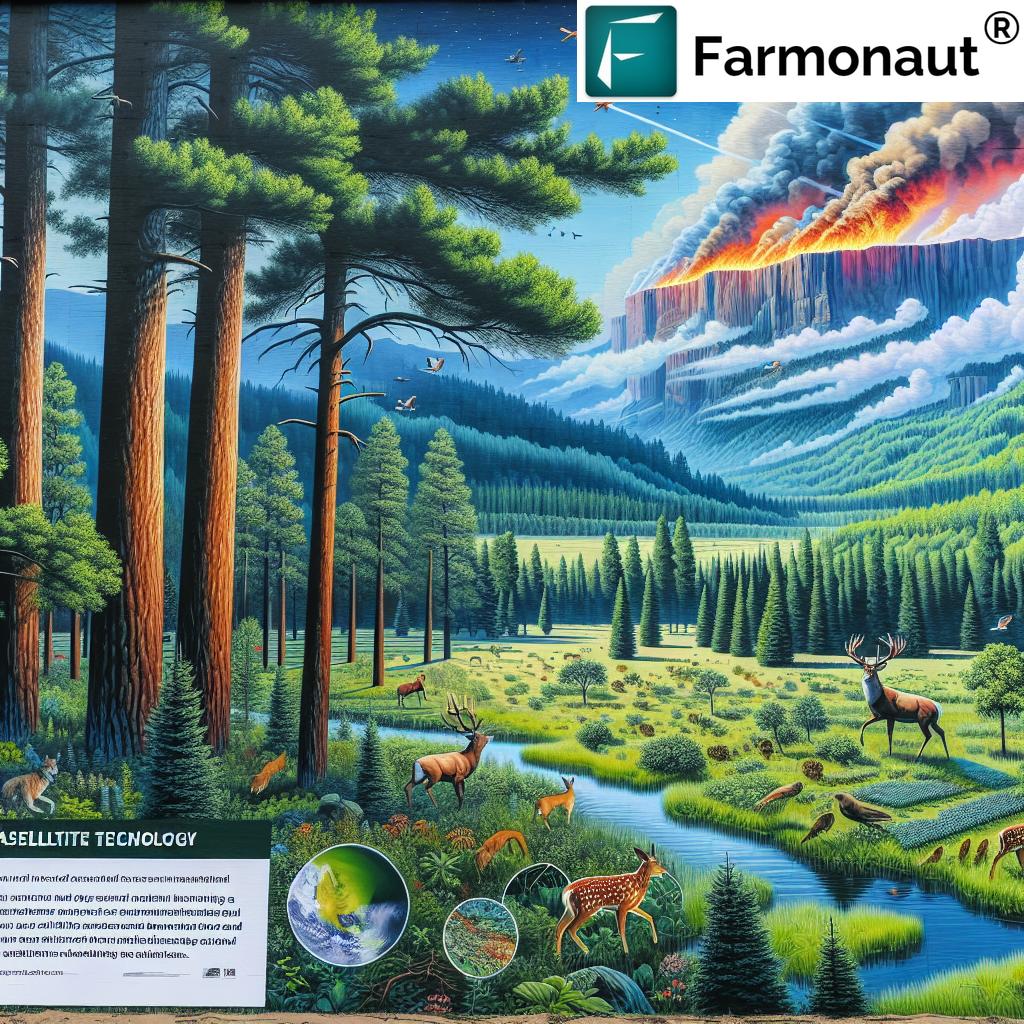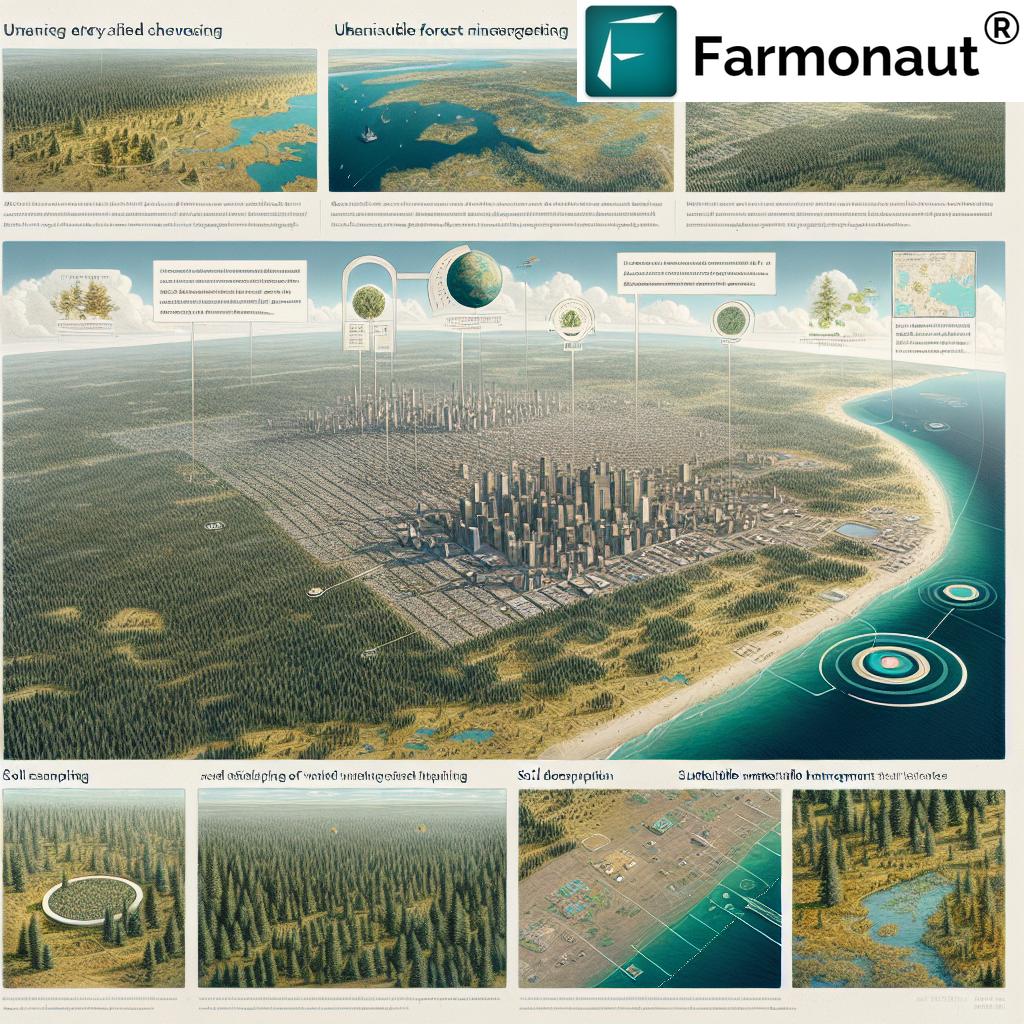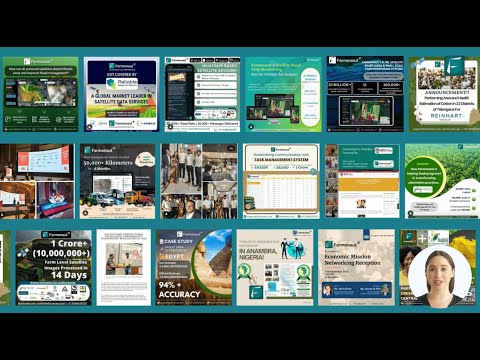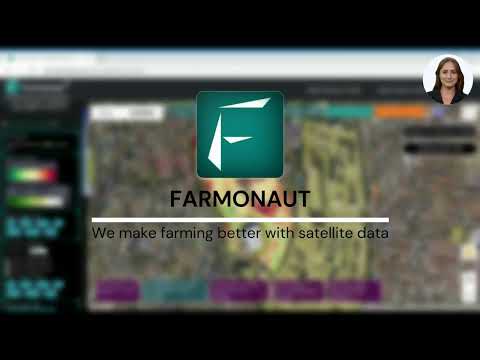Sustainable Forestry Practices: How Farmonaut’s Technology Protects Portsmouth’s Natural Resources
“Shawnee State Forest, known as ‘The Little Smokies of Ohio,’ spans 60,000 acres of diverse landscape.”

In the heart of Portsmouth, Ohio, a vibrant mural on the iconic floodwall tells a powerful story of sustainable forestry practices and wildfire prevention techniques. This artistic tribute to Shawnee State Forest, affectionately known as “The Little Smokies of Ohio,” serves as a reminder of the importance of forest conservation methods and wildlife habitat management. As we delve into the world of sustainable forestry, we’ll explore how cutting-edge technology, including Farmonaut’s innovative solutions, is revolutionizing the way we protect and manage our natural resources.
The Mural: A Canvas for Conservation
The latest addition to Portsmouth’s floodwall, created by renowned artist Robert Dafford, showcases the dedication of wildland firefighters and the beauty of Shawnee State Forest. This artistic masterpiece not only captures the essence of forest protection but also highlights the broader significance of sustainable forestry practices to rural communities across Ohio.
Let’s break down the key elements depicted in this mural and how they relate to modern forestry management:
- Wildland firefighters in action
- Smokey Bear, the iconic symbol of forest fire prevention
- Diverse landscapes of Shawnee State Forest
- Sustainable timber harvesting scenes
- Wildlife in their natural habitats
Each of these elements represents a crucial aspect of sustainable forestry practices that we’ll explore in detail throughout this article.
Shawnee State Forest: A Model for Sustainable Forestry
Spanning over 60,000 acres, Shawnee State Forest is a prime example of how sustainable forestry practices can coexist with recreational use and wildlife conservation. The forest serves multiple purposes, including:
- Timber harvesting
- Wildlife habitat management
- Watershed protection
- Recreational activities
- Research and education
These diverse functions demonstrate the complexity of modern forestry management and the need for advanced technologies to maintain this delicate balance.
Wildfire Prevention: A Critical Component of Forest Conservation
One of the most pressing concerns in forestry management is wildfire prevention. In Shawnee State Forest, dedicated forest crews from the Ohio Department of Natural Resources (ODNR) work tirelessly during critical fire danger periods, typically in spring and fall, to detect and suppress wildfires. This effort extends beyond state lands to protect surrounding private properties as well.
Traditional wildfire prevention techniques include:
- Regular patrols
- Watchtower observations
- Public education campaigns
- Controlled burns
However, with the advent of technology, we’re seeing a revolution in how we approach forest fire detection systems.
Farmonaut’s Role in Modern Forestry Management
“Farmonaut’s satellite technology aids in monitoring forest health and developing sustainable tree planting strategies across Portsmouth’s natural resources.”
At Farmonaut, we’re proud to contribute to the field of sustainable forestry through our advanced satellite-based technologies. Our platform offers valuable insights that complement traditional forestry practices, enhancing the overall health and sustainability of forests like Shawnee State Forest.

Here’s how our technology is making a difference:
- Satellite-Based Crop Health Monitoring: While primarily used for agricultural purposes, this technology can be adapted to monitor forest health on a large scale.
- AI Advisory System: Our Jeevn AI can provide real-time insights on forest conditions, helping forestry managers make informed decisions.
- Carbon Footprinting: This feature allows for accurate tracking of carbon sequestration in forested areas, crucial for climate change mitigation efforts.
To learn more about how Farmonaut’s technology can be applied to forestry management, check out our web app or download our mobile apps:
Innovative Forest Fire Detection Systems
Advancements in technology have revolutionized how we detect and respond to forest fires. Modern forest fire detection systems include:
- Satellite imagery analysis
- Drone surveillance
- IoT sensors
- AI-powered prediction models
These technologies allow for earlier detection and faster response times, significantly reducing the potential damage caused by wildfires.
Sustainable Timber Harvesting: Balancing Economic and Environmental Needs
Timber harvesting is a crucial economic activity in Shawnee State Forest, but it must be conducted sustainably to preserve the forest’s long-term health. Sustainable timber harvesting practices include:
- Selective cutting
- Reforestation efforts
- Rotation of harvest areas
- Protection of biodiversity hotspots
Modern timber harvesting technology, such as precision forestry tools and GPS-guided machinery, helps minimize environmental impact while maximizing efficiency.
Wildlife Habitat Management: Preserving Biodiversity
Effective wildlife habitat management is essential for maintaining the rich biodiversity of Shawnee State Forest. This involves:
- Creating and maintaining diverse habitats
- Protecting endangered species
- Managing invasive species
- Implementing wildlife corridors
Farmonaut’s satellite imagery can be utilized to monitor habitat changes over time, providing valuable data for wildlife management decisions.
Rural Community Development: Forests as Economic Engines
Sustainable forestry practices play a vital role in rural community development. Forests like Shawnee State Forest contribute to local economies through:
- Job creation in forestry and related industries
- Eco-tourism opportunities
- Sustainable resource production
- Educational and research facilities
By balancing economic needs with conservation efforts, we can ensure that forests continue to support rural communities for generations to come.
Soil and Watershed Management: The Foundation of Forest Health
Proper soil and watershed management is crucial for maintaining forest health and preventing erosion. Key practices include:
- Implementing erosion control measures
- Maintaining riparian buffers
- Monitoring soil quality
- Managing water resources
Farmonaut’s technology can assist in monitoring soil moisture levels and watershed conditions, providing valuable data for forest managers.
Sustainable Tree Planting Strategies: Ensuring Future Forests
Reforestation and afforestation efforts are essential components of sustainable forestry. Modern tree planting strategies involve:
- Species selection based on local conditions
- Use of native species
- Consideration of future climate scenarios
- Implementation of mixed-species plantations
Farmonaut’s AI-powered advisory system can provide recommendations for optimal tree planting based on local conditions and historical data.
The Role of Technology in Modern Forestry
As we’ve seen throughout this article, technology plays an increasingly important role in sustainable forestry practices. From satellite imagery to AI-powered predictions, these tools are helping us manage our forests more effectively than ever before.
For those interested in leveraging technology for forestry management, Farmonaut offers an API that can be integrated into existing systems. Our API Developer Docs provide all the information needed to get started.
Comparative Analysis: Traditional vs. Technology-Enhanced Forestry Practices
| Practice | Traditional Method | Farmonaut-Enhanced Method |
|---|---|---|
| Forest Fire Detection | Ground patrols and watchtowers | Satellite imagery analysis for early detection |
| Timber Harvesting | Manual selection and harvesting | AI-assisted selection and precision harvesting |
| Wildlife Habitat Management | Periodic ground surveys | Real-time satellite monitoring of habitat changes |
| Soil Conservation | Periodic soil sampling | Continuous soil moisture and health monitoring |
| Tree Health Monitoring | Visual inspections | AI-powered analysis of multispectral imagery |
The Future of Sustainable Forestry
As we look to the future, it’s clear that sustainable forestry practices will continue to evolve, driven by advances in technology and our growing understanding of forest ecosystems. Some trends to watch include:
- Increased use of AI and machine learning in forest management
- Development of more resilient tree species through genetic research
- Integration of forests into urban planning (urban forestry)
- Greater emphasis on forests’ role in climate change mitigation
By embracing these innovations and continuing to prioritize sustainability, we can ensure that forests like Shawnee State Forest continue to thrive for generations to come.
Conclusion: A Sustainable Future for Portsmouth’s Forests
The mural on Portsmouth’s floodwall serves as a beautiful reminder of the importance of sustainable forestry practices. From wildfire prevention to wildlife habitat management, every aspect of forest conservation plays a crucial role in maintaining the health of our natural resources.
As we’ve explored in this article, the integration of advanced technologies like those offered by Farmonaut is revolutionizing how we approach forestry management. By combining traditional knowledge with cutting-edge tools, we can create a more sustainable and resilient future for our forests.
We encourage everyone to take an active interest in forest conservation efforts. Whether it’s supporting local initiatives, educating ourselves about sustainable practices, or utilizing technologies like Farmonaut to make informed decisions, we all have a role to play in protecting our natural heritage.
FAQ Section
Q: What are sustainable forestry practices?
A: Sustainable forestry practices are methods of managing and using forest resources in a way that maintains forest health, biodiversity, and productivity for current and future generations. This includes responsible timber harvesting, wildlife habitat management, soil conservation, and fire prevention techniques.
Q: How does Farmonaut’s technology contribute to sustainable forestry?
A: Farmonaut’s satellite-based technology provides valuable data for forest health monitoring, fire detection, and sustainable tree planting strategies. Our AI-powered advisory system can offer insights to help forestry managers make informed decisions about resource management and conservation efforts.
Q: Why is wildfire prevention important in sustainable forestry?
A: Wildfire prevention is crucial because uncontrolled fires can devastate forest ecosystems, destroy wildlife habitats, and release large amounts of carbon into the atmosphere. Effective prevention and early detection strategies help maintain forest health and protect surrounding communities.
Q: How does sustainable forestry benefit rural communities?
A: Sustainable forestry practices contribute to rural community development by creating jobs in forestry and related industries, promoting eco-tourism, providing sustainable resources, and offering educational and research opportunities. This helps maintain a balance between economic needs and environmental conservation.
Q: What role does technology play in modern forestry management?
A: Technology plays an increasingly important role in forestry management, from satellite imagery and AI-powered predictions to precision harvesting tools. These technologies help forest managers monitor forest health, detect issues early, and make data-driven decisions for more effective and sustainable forest management.
By embracing sustainable forestry practices and leveraging innovative technologies, we can ensure that Portsmouth’s natural resources, including the beloved Shawnee State Forest, continue to thrive for generations to come. Let’s work together to protect and preserve these invaluable ecosystems.






